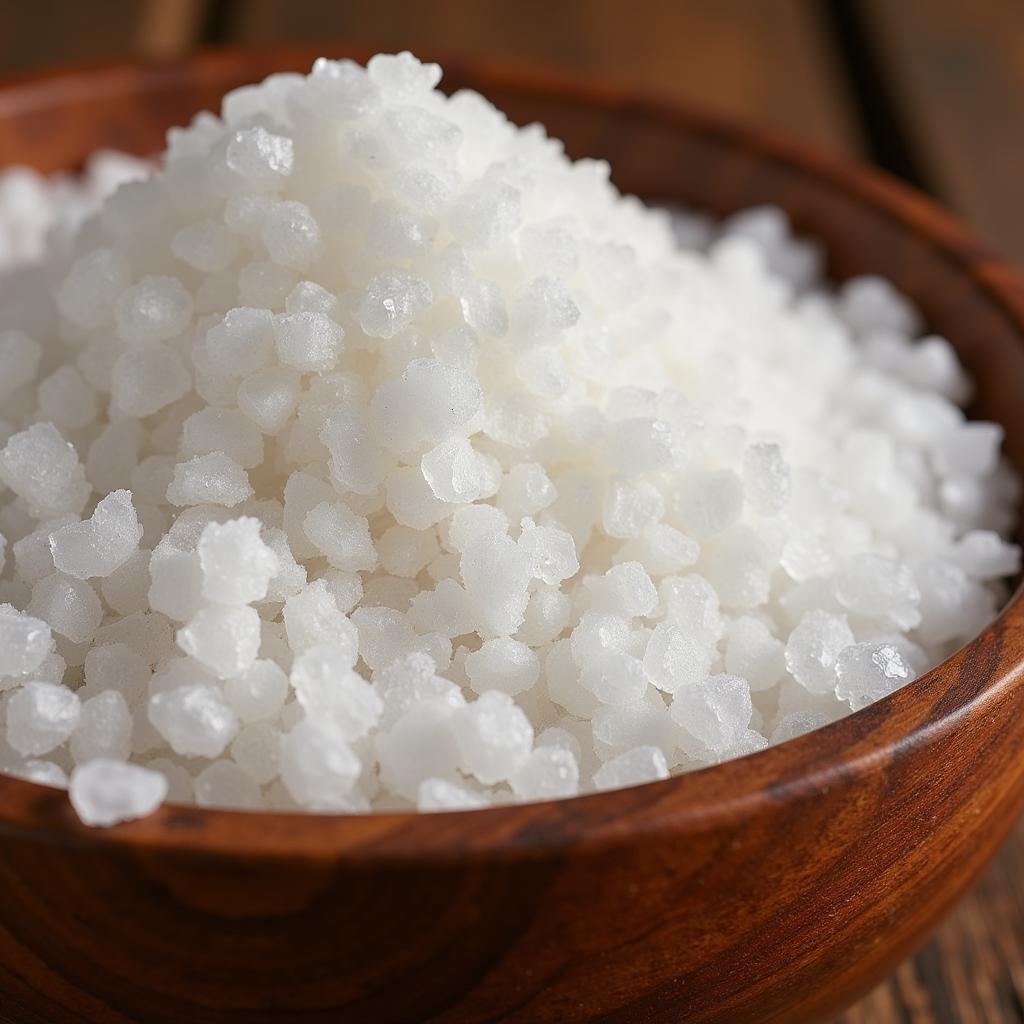Epsom salt is a common household item with a variety of uses, including as a poultice for horses. An epsom salt poultice can help to draw out inflammation, reduce swelling, and soothe sore muscles. But how does it work and when should you use it on your equine companion? This comprehensive guide will delve into the benefits, uses, and precautions of using epsom salt poultices for horses.
Understanding Epsom Salt and its Benefits
Epsom salt, chemically known as magnesium sulfate, is not actually salt but a naturally occurring mineral compound. When absorbed through the skin, magnesium plays a vital role in muscle and nerve function, reducing inflammation, and improving blood flow. Sulfate, on the other hand, aids in flushing toxins and reducing pain.
 Epsom salt crystals in a wooden bowl
Epsom salt crystals in a wooden bowl
When to Consider an Epsom Salt Poultice for your Horse
Epsom salt poultices are a popular choice for addressing a range of equine ailments due to their anti-inflammatory and drawing properties. Here are some common scenarios where an epsom salt poultice may be beneficial:
- Abscesses: Epsom salt can help draw out infection and reduce swelling associated with abscesses.
- Strained Tendons and Ligaments: Applying an epsom salt poultice can help reduce inflammation and promote healing in injured tendons and ligaments.
- Muscle Soreness and Stiffness: After strenuous activity, an epsom salt poultice can soothe sore muscles and alleviate stiffness in horses.
- Hoof Abscesses: For hoof abscesses, soaking the hoof in a warm epsom salt solution can be particularly helpful in softening the hoof and drawing out the infection.
 Equine leg wrapped in a poultice
Equine leg wrapped in a poultice
How to Make an Epsom Salt Poultice
Preparing an epsom salt poultice is a straightforward process:
- Gather your materials: You will need epsom salt, warm water, a clean bowl, gauze pads or cotton wool, and a bandage.
- Mix the solution: Dissolve epsom salt in warm water to create a concentrated solution. The general ratio is one cup of epsom salt to one gallon of water.
- Prepare the poultice: Soak the gauze pads or cotton wool in the epsom salt solution, ensuring they are thoroughly saturated.
- Apply to the affected area: Gently squeeze out excess solution from the poultice and apply it directly to the affected area on your horse.
- Secure the poultice: Use a bandage to hold the poultice in place. Ensure the bandage is snug but not too tight to restrict blood flow.
Precautions and Considerations
While generally safe, it’s crucial to exercise caution when using epsom salt poultices on horses.
- Consult your Veterinarian: Before using any new treatment on your horse, always consult with your veterinarian to ensure its appropriateness and safety.
- Open Wounds: Avoid using epsom salt poultices on open wounds, as it can irritate the tissues and delay healing.
- Ingestion: Prevent your horse from ingesting the epsom salt solution, as it can cause diarrhea.
For more information on the various uses of epsom salt for horses, you can visit our comprehensive guide on epsom salt for horses.
Conclusion
Epsom salt poultices are a valuable tool for horse owners to have in their first-aid kit. Their ability to reduce inflammation, alleviate pain, and promote healing makes them beneficial for a range of equine ailments. By understanding how to use them safely and effectively, you can provide your horse with relief and support their recovery. Remember to always consult with your veterinarian before administering any new treatment to your horse.
FAQs about Epsom Salt Poultices for Horses
Q: Can I leave an epsom salt poultice on my horse overnight?
A: It’s best to avoid leaving an epsom salt poultice on your horse for extended periods. The general recommendation is to replace the poultice every 12 hours.
Q: How often can I apply an epsom salt poultice to my horse?
A: You can typically apply an epsom salt poultice 1-2 times daily, depending on the severity of the condition and your veterinarian’s recommendations.
Q: Can I use epsom salt on my horse’s open wound?
A: It’s advisable to avoid applying epsom salt to open wounds, as it can be irritating and hinder the healing process.
Q: My horse licked the epsom salt poultice. Should I be concerned?
A: While small amounts are unlikely to cause significant harm, ingesting large amounts of epsom salt can lead to diarrhea in horses. Monitor your horse for any digestive upset and contact your veterinarian if you notice any adverse reactions.
Q: Are there any alternatives to epsom salt poultices for horses?
A: Yes, there are alternative poultice options available, such as clay-based poultices or commercially prepared products. Your veterinarian can advise on the most suitable option for your horse’s specific condition.
Need More Help?
If you need further assistance or have more questions, don’t hesitate to contact us. Our dedicated team at Justus Horses USA is available 24/7 to provide support and guidance. You can reach us at:
Phone Number: 0772127271
Email: [email protected]
Address: QGM2+WX2, Vị Trung, Vị Thuỷ, Hậu Giang, Việt Nam
Let us help you ensure the well-being of your equine companion!